Long overdue to visit friends in Pasadena, my husband and I planned a weekend of catching up with new stuff—a hotel, a museum, and and three high-profile restaurants—in Los Angeles. The trip came hard on the heels of Mexico City, but we’re nowhere near the red zone of too much travel.
The first stop was the Hammer Museum, not new but new to Adam and me, and I think I mistook it for the Norton Simon, because I assumed that the museum was mainly about a permanent collection and didn’t bother to look into what was showing. Good thing the Hammer is free: only two itty-bitty galleries were open, one with video art and the other with an assemblage of landscape tools and materials. My empathic muscle just doesn’t stretch that far.
In any event, we were mainly there for the restaurant: Lulu, the first time legendary chef/restauranteur Alice Waters has ever opened anything besides Chez Panisse. And helming the kitchen is David Tanis, whose recipes for the New York Times we regularly cook at home. Lulu is only open for lunch at this time, with a three-course prix fixe and a “bar menu” of à la carte items. (Here’s the menu the day we went.) The prix fixe had braised pork shoulder as the entrée, which seemed heavy for lunch, so instead we ordered bread, black bean soup, goat cheese and chicory salads, eggplant banh mi, and pistachio cake with coconut cream. The soup and the goat cheese salad were standouts, prime examples of the Waters/Tanis philosophy of doing as little as possible to excellent ingredients. But that can result in a lack of fireworks.
So, for us, Lulu was less about the food and more about the joy of being in a well-run big-city restaurant. Dining outside in a courtyard, versus in a parking lot or on the sidewalk/street, is a delight (despite the banquette being way higher than the chairs), and the hostess was fabulous. I wouldn’t normally run someone’s photo without asking, but she’s dressed to attract attention and has the personality to carry it off.
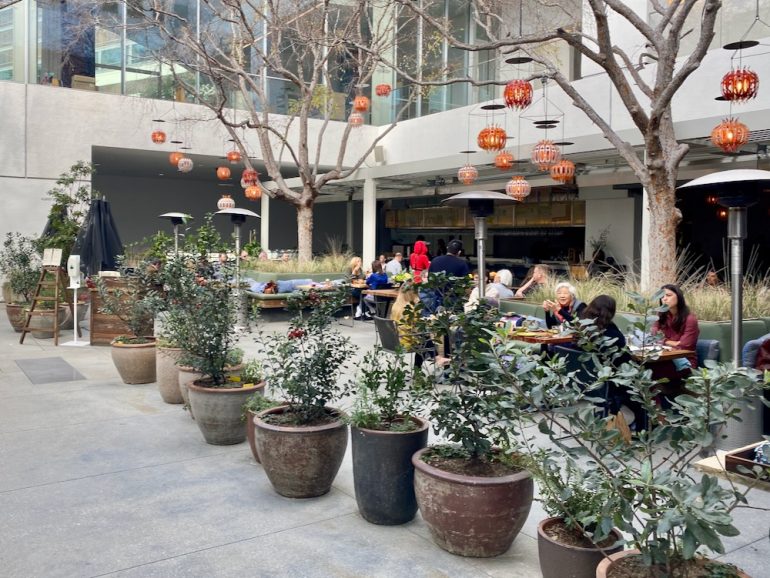
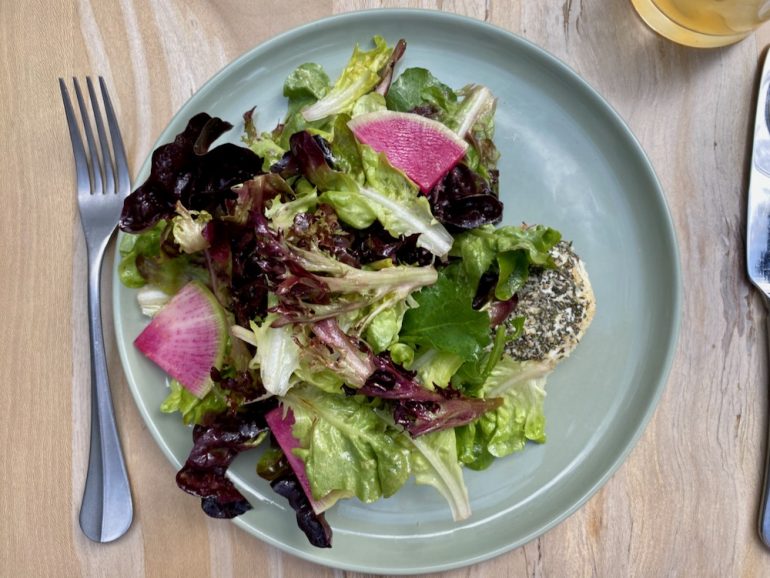
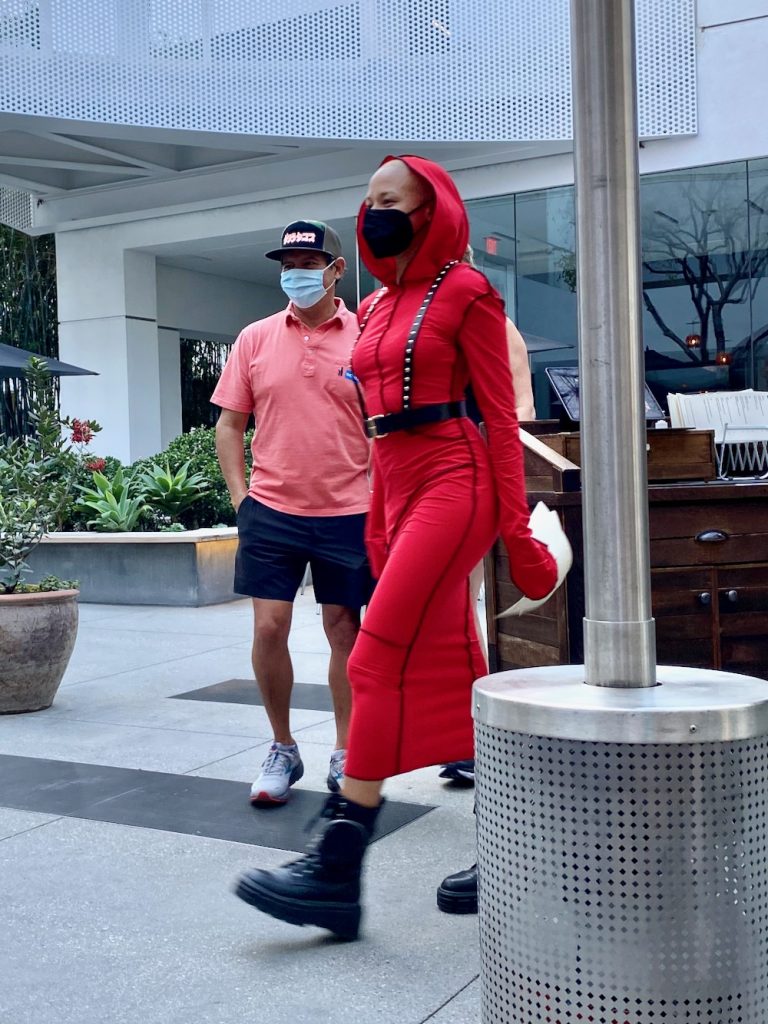 After a photo op in the courtyard’s Thomas Heatherwick’s Spun Chairs and a stop at the Buck Mason flagship in Hancock Park—a brand I think could do well in Santa Barbara—we headed to the new Downtown L.A. Proper Hotel. I arrived with a chip on my shoulder: I had opted for the non-changeable “Book early and save” rate two months earlier, only to see that days before our arrival, a “Proper Grand Opening” rate was available for $22 less, and it included a $30 food-and-beverage credit, and it could be modified or canceled. The front desk was lovely about giving me the better rate; the moral is to keep looking up till you arrive.
After a photo op in the courtyard’s Thomas Heatherwick’s Spun Chairs and a stop at the Buck Mason flagship in Hancock Park—a brand I think could do well in Santa Barbara—we headed to the new Downtown L.A. Proper Hotel. I arrived with a chip on my shoulder: I had opted for the non-changeable “Book early and save” rate two months earlier, only to see that days before our arrival, a “Proper Grand Opening” rate was available for $22 less, and it included a $30 food-and-beverage credit, and it could be modified or canceled. The front desk was lovely about giving me the better rate; the moral is to keep looking up till you arrive.
The old building—a private club in the 1920s and a YWCA in the 1960s—has obvious appeal, and Kelly Wearstler stamped the interiors with her trademark maximalist style, but as is often the case in old buildings, rooms are small. I had to scrunch myself into a corner to take the photo of our Premium King View room. And the odd two-top at the foot of the bed rendered the loveseat useless. Imagine trying to put on your shoes.
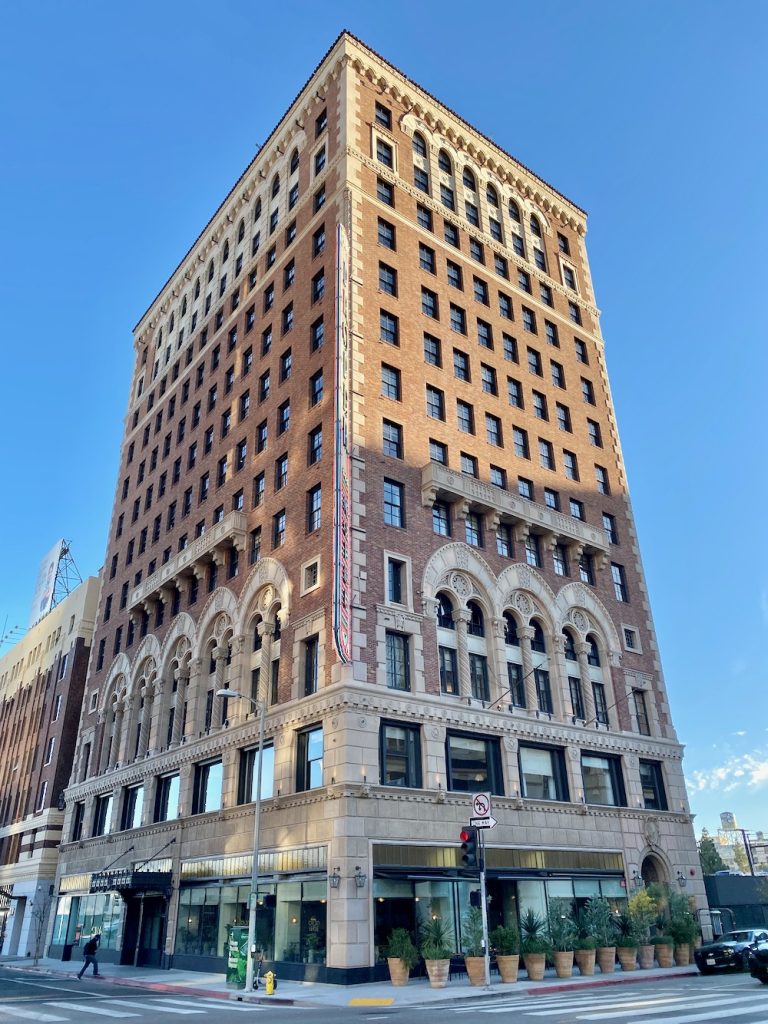
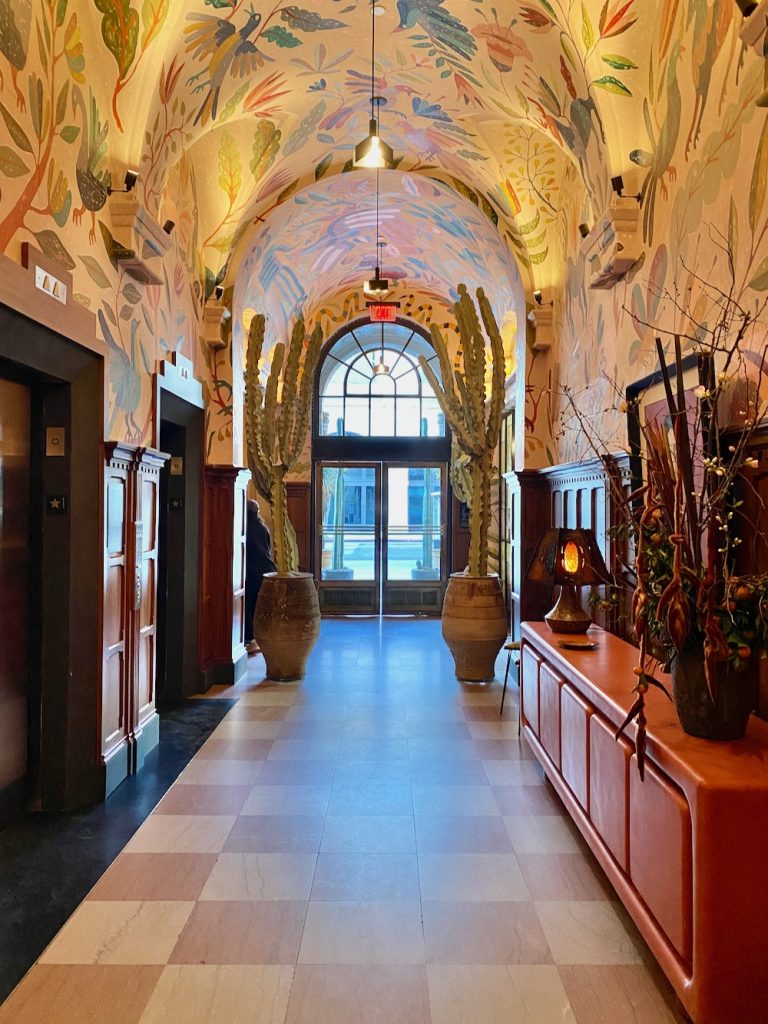
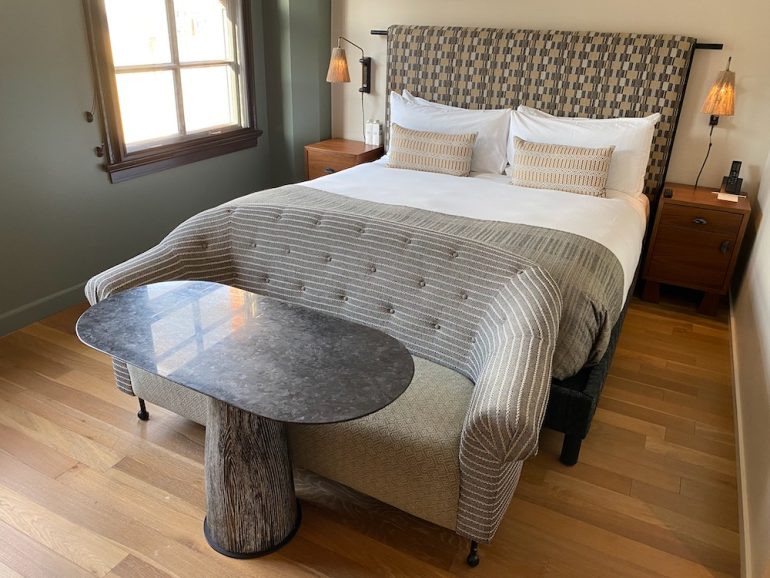 The best part of the hotel is the roof deck, home to a restaurant/bar called Cara Cara. When we went up later for a drink, the night was so clear we could see airplanes all over the place and even stars.
The best part of the hotel is the roof deck, home to a restaurant/bar called Cara Cara. When we went up later for a drink, the night was so clear we could see airplanes all over the place and even stars.
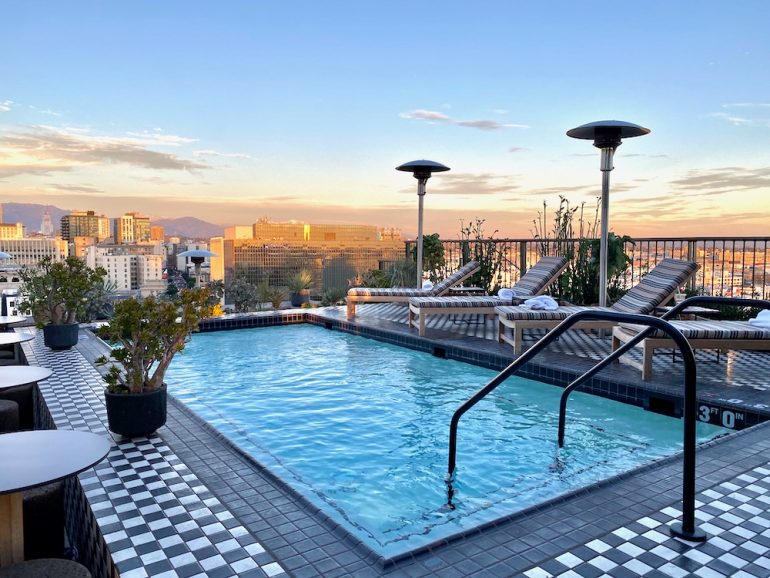
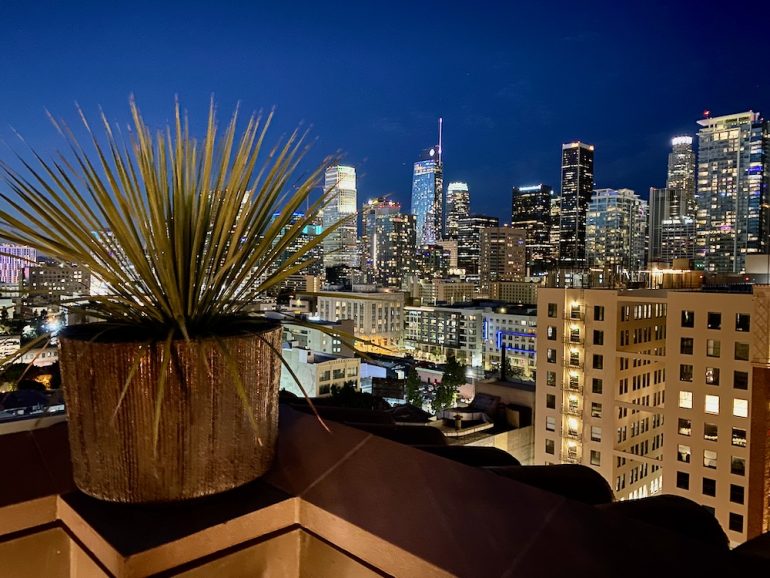 But first, we walked around downtown L.A., an area I have little familiarity with. I knew it had been rediscovered in the past decade or two, but I had no idea how the old and the new exist side by side in ways that can be disorienting: you think you’re on a skanky street and then you see a Nike store. As in any city, I admired the architecture and the quirky signage.
But first, we walked around downtown L.A., an area I have little familiarity with. I knew it had been rediscovered in the past decade or two, but I had no idea how the old and the new exist side by side in ways that can be disorienting: you think you’re on a skanky street and then you see a Nike store. As in any city, I admired the architecture and the quirky signage.
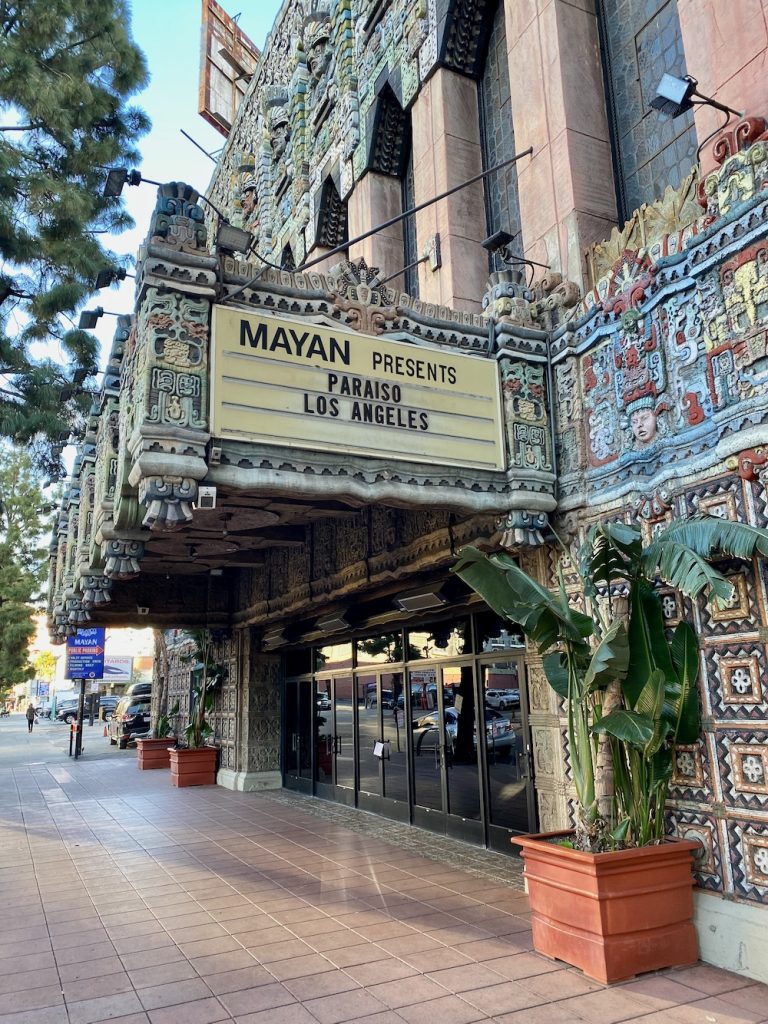
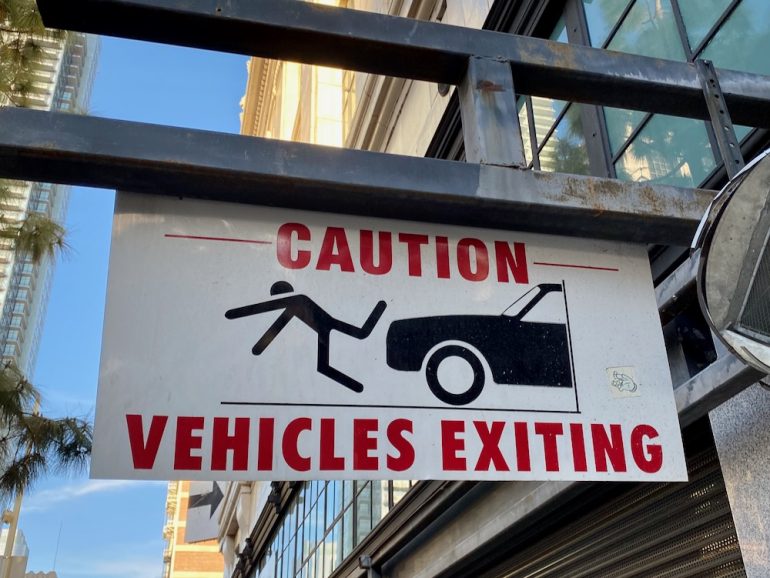
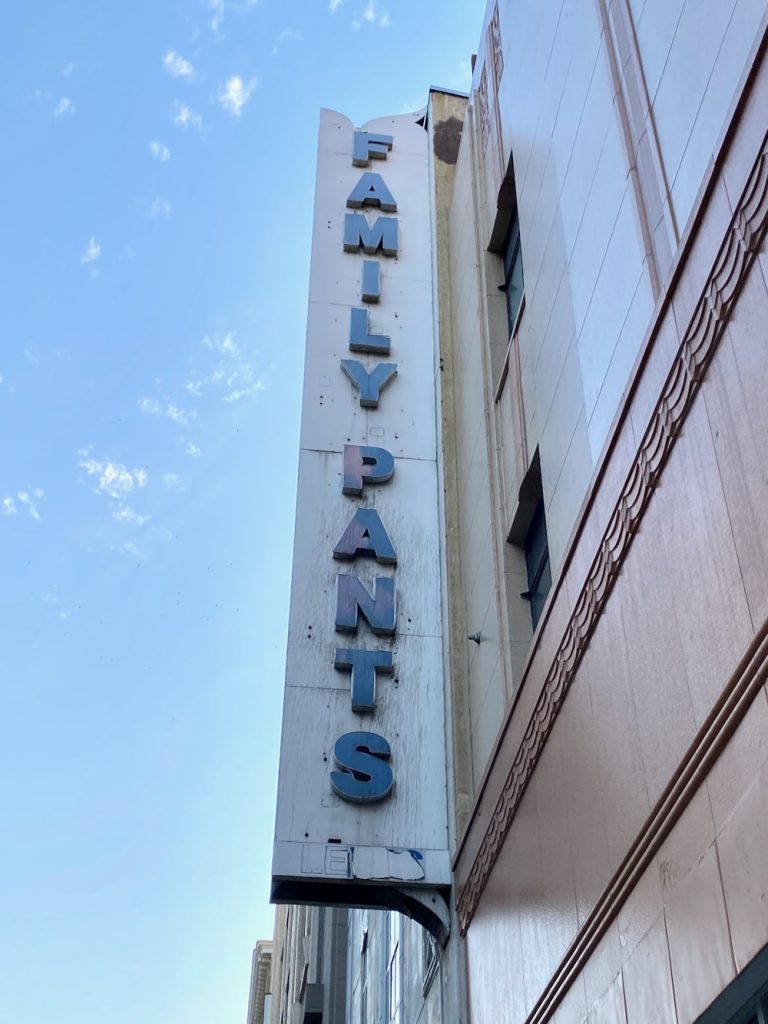
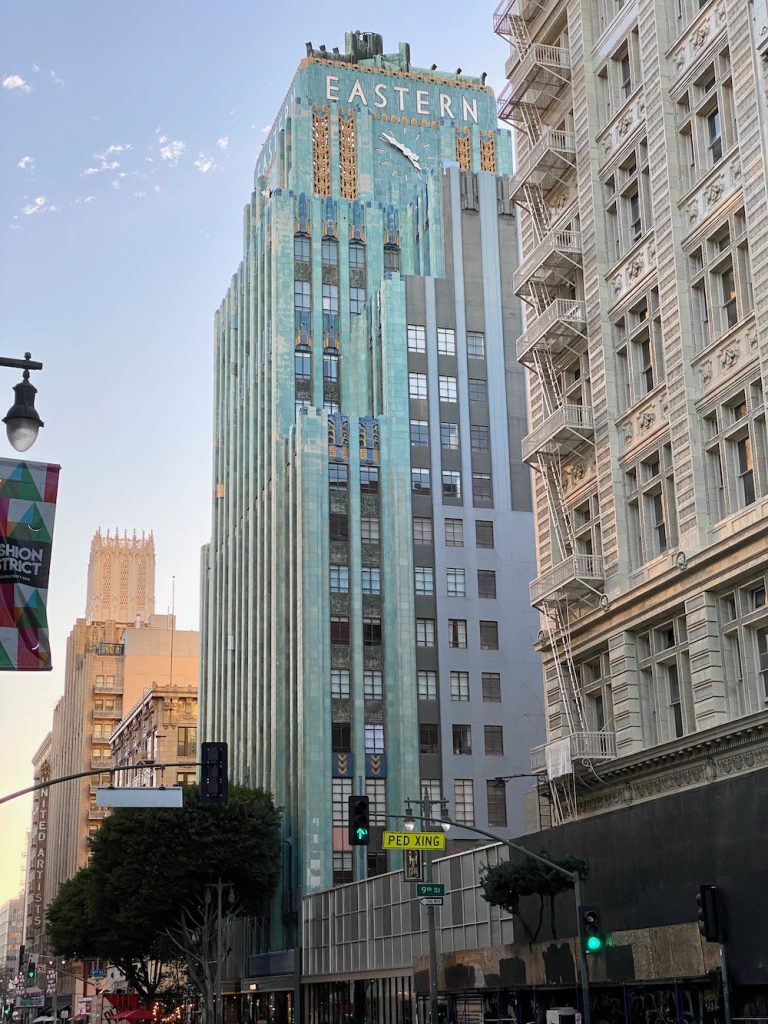 Our destination was the Central Library. I had just read The Library Book by Susan Orlean and wanted to see the building she wrote about in such wonderful detail. Love the rotunda ceiling.
Our destination was the Central Library. I had just read The Library Book by Susan Orlean and wanted to see the building she wrote about in such wonderful detail. Love the rotunda ceiling.
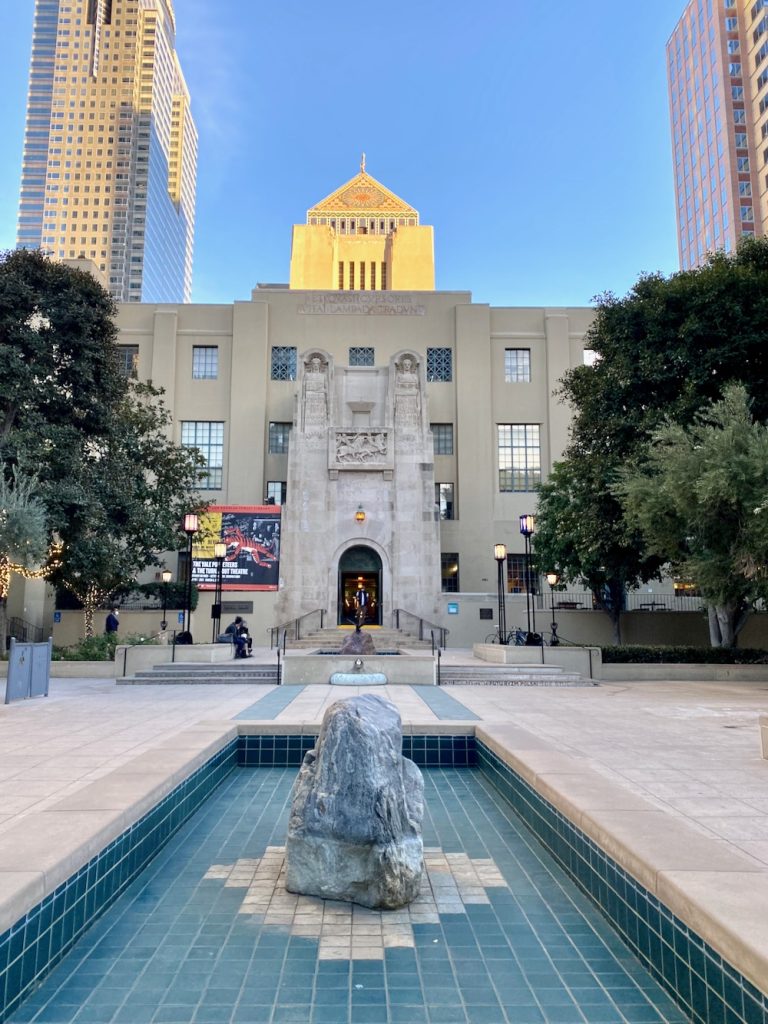
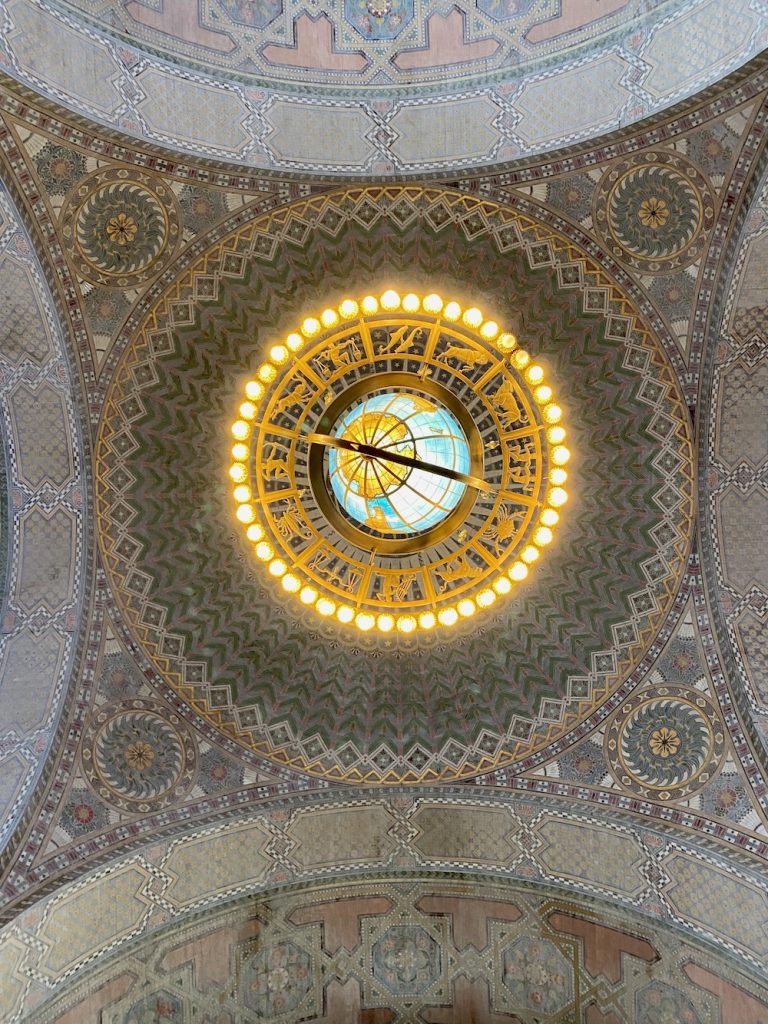 We had chosen the Proper for one reason: chef Suzanne Goin has two new restaurants there—the aforementioned Cara Cara and, on the ground floor, Caldo Verde—and we worship her cookbooks, Sunday Suppers at Lucques and The A.O.C. Cookbook. Dinner at Caldo Verde, however, was a serious disappointment: the food peaked at fair, and despite the extra decor, the establishment felt soulless, the way so many hotel restaurants do. After four subpar Goin meals in a row, we’ve grown convinced that her heart is elsewhere. (Breakfast the next day was somewhat better, but that’s relatively low-hanging fruit.)
We had chosen the Proper for one reason: chef Suzanne Goin has two new restaurants there—the aforementioned Cara Cara and, on the ground floor, Caldo Verde—and we worship her cookbooks, Sunday Suppers at Lucques and The A.O.C. Cookbook. Dinner at Caldo Verde, however, was a serious disappointment: the food peaked at fair, and despite the extra decor, the establishment felt soulless, the way so many hotel restaurants do. After four subpar Goin meals in a row, we’ve grown convinced that her heart is elsewhere. (Breakfast the next day was somewhat better, but that’s relatively low-hanging fruit.)
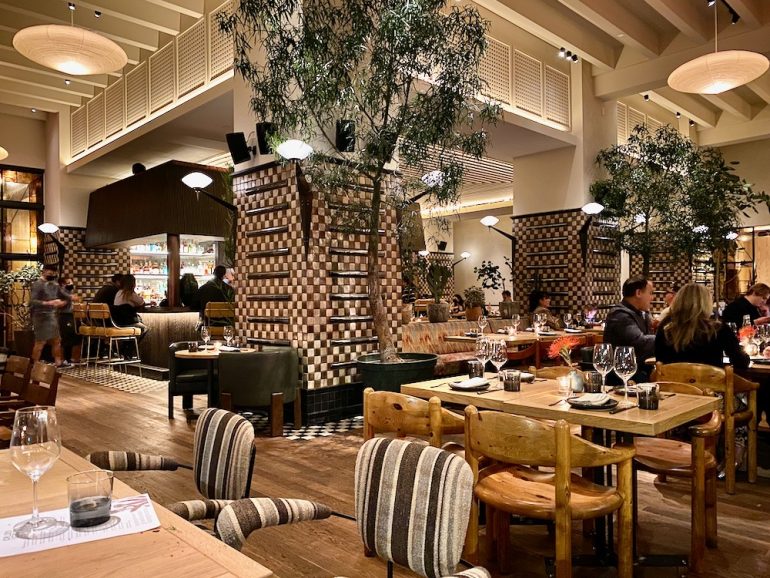 In the morning, we went to the five-acre 7th Street Produce Market, open from midnight to noon. We were the only tourists, but we were on a quest for mamey, the fruit we had discovered in Mexico City. After looking at every stall—and there were a lot of them—we finally found two huge mameys, along with a case of ataulfo mangoes and some mole. The mameys weren’t as good as in Mexico, but the adventure was sublime.
In the morning, we went to the five-acre 7th Street Produce Market, open from midnight to noon. We were the only tourists, but we were on a quest for mamey, the fruit we had discovered in Mexico City. After looking at every stall—and there were a lot of them—we finally found two huge mameys, along with a case of ataulfo mangoes and some mole. The mameys weren’t as good as in Mexico, but the adventure was sublime.
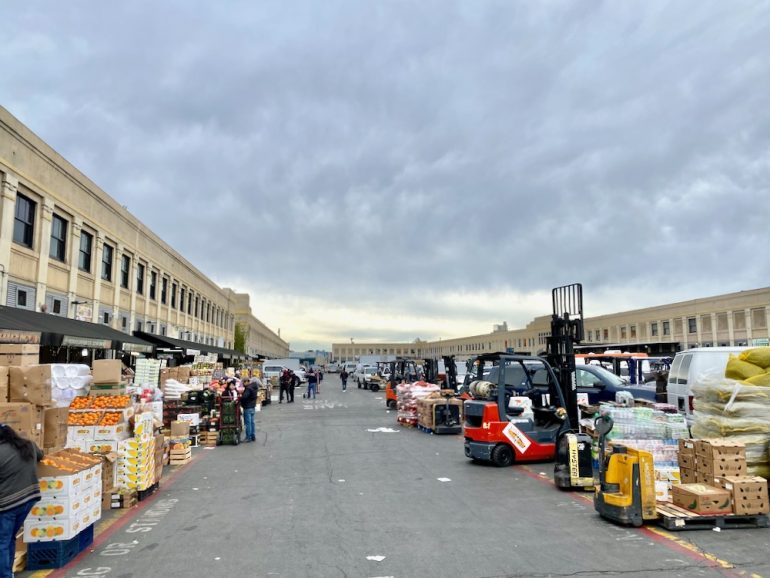
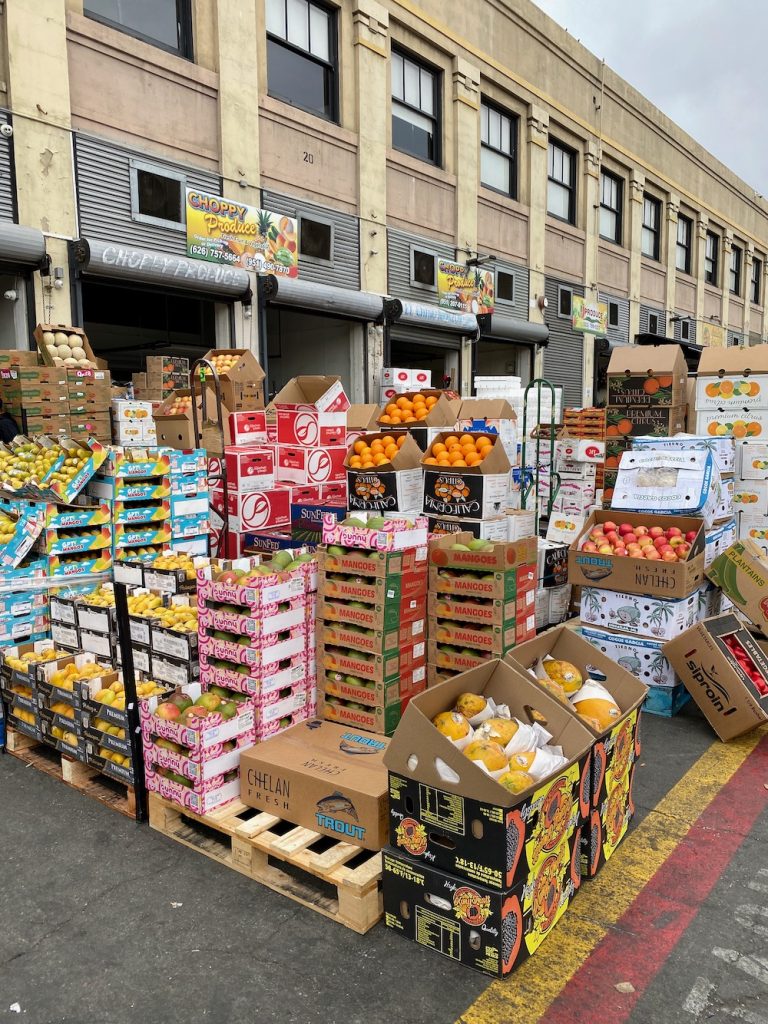
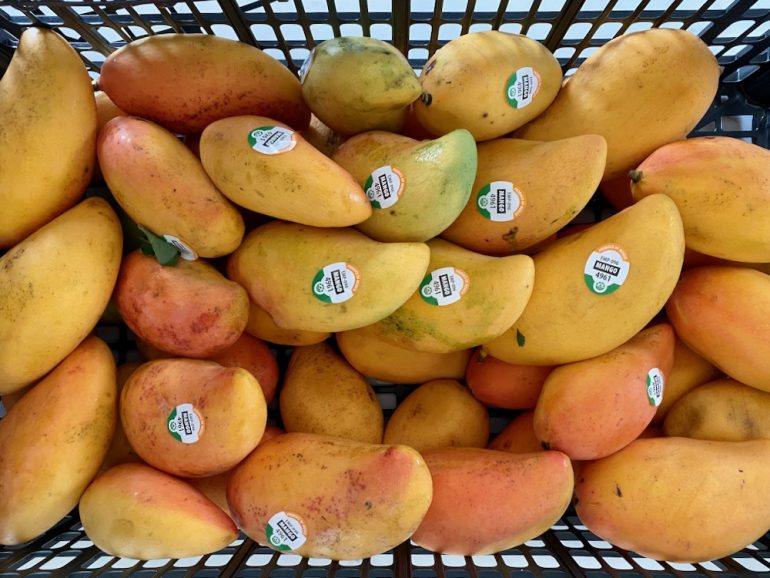 Our friends live in the Pasadena/La Cañada Flintridge area, which feels sort of like the Santa Barbara foothills. Two highlights of our visit were Descanso Gardens, where the many varieties of camellia are in bloom (go soon!), and the gelato at Bulgarini in Altadena.
Our friends live in the Pasadena/La Cañada Flintridge area, which feels sort of like the Santa Barbara foothills. Two highlights of our visit were Descanso Gardens, where the many varieties of camellia are in bloom (go soon!), and the gelato at Bulgarini in Altadena.
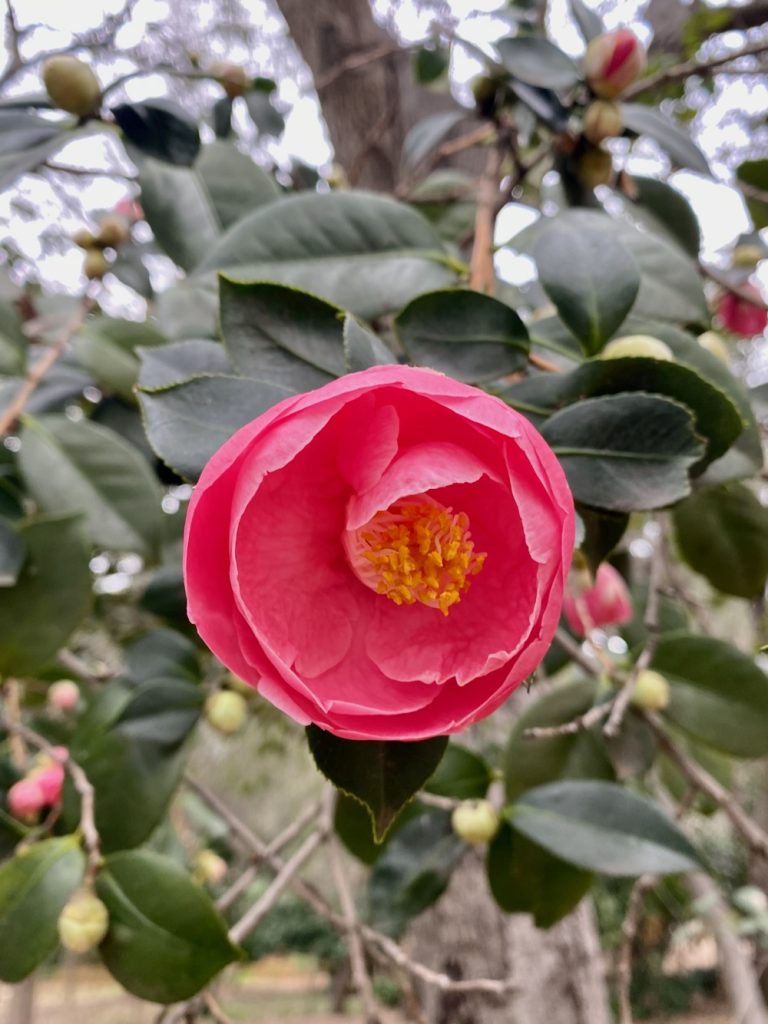 The next day, we drove to the new Academy Museum of Motion Pictures, next to the L.A. County Museum of Art. The museum is inside the former May Company Building, with a bulbous, brutalist theater attached by catwalks. The architecture and design of the museum is as far as you can get from the pastiche movie palaces of yore. Maybe the idea was to contrast with the glamour on display in the exhibits, but the building could be a museum for anything. (The shark is fun, though.) And the gallery organization is confusing. On each floor, we had to ask which door to enter, often with no idea what we’d find inside. We weren’t the only folks who were confused: I watched as a couple interpreted an “exit route” sign to mean that the gallery nearby was closed, when the sign was totally unrelated.
The next day, we drove to the new Academy Museum of Motion Pictures, next to the L.A. County Museum of Art. The museum is inside the former May Company Building, with a bulbous, brutalist theater attached by catwalks. The architecture and design of the museum is as far as you can get from the pastiche movie palaces of yore. Maybe the idea was to contrast with the glamour on display in the exhibits, but the building could be a museum for anything. (The shark is fun, though.) And the gallery organization is confusing. On each floor, we had to ask which door to enter, often with no idea what we’d find inside. We weren’t the only folks who were confused: I watched as a couple interpreted an “exit route” sign to mean that the gallery nearby was closed, when the sign was totally unrelated.
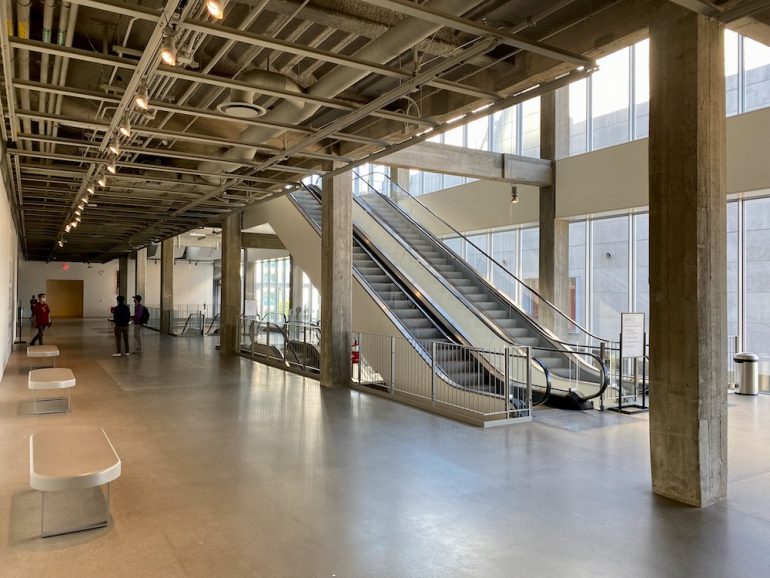
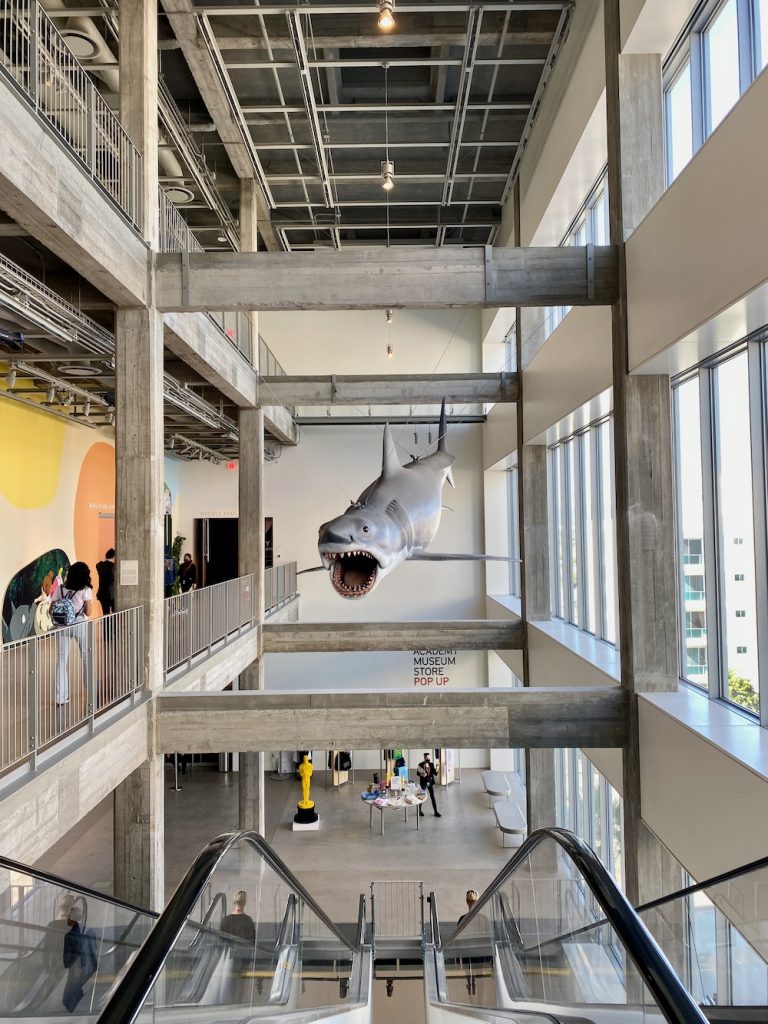 One exception to the industrial drabness was the Academy Award room. Unfortunately, that’s as close as I was able to get to one, because the Oscars Experience, where you pay $15 extra to have your photo taken clutching an award, was canceled for Covid-related reasons. (Adam says no one will care about this next part, but it’s my blog and I’ll whine if I want to: the museum neither warned us in advance the Oscars Experience would be closed nor mentioned a refund until I asked about it.)
One exception to the industrial drabness was the Academy Award room. Unfortunately, that’s as close as I was able to get to one, because the Oscars Experience, where you pay $15 extra to have your photo taken clutching an award, was canceled for Covid-related reasons. (Adam says no one will care about this next part, but it’s my blog and I’ll whine if I want to: the museum neither warned us in advance the Oscars Experience would be closed nor mentioned a refund until I asked about it.)
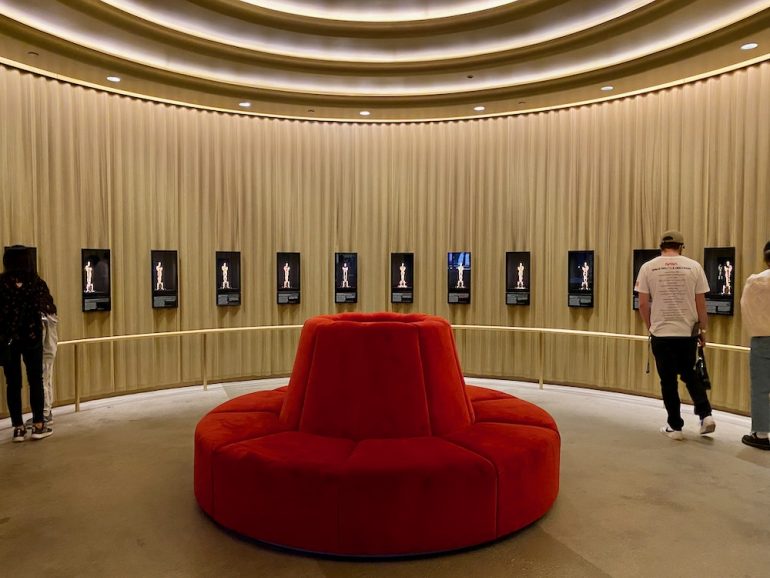 Several rooms are devoted to movie clips, reminiscent of the random montages that bulk out the Academy Awards. Without context or analysis, you don’t know why you’re being shown The Shining or Fast Times at Ridgemont High or whatever—there’s just the limited thrill of recognition.
Several rooms are devoted to movie clips, reminiscent of the random montages that bulk out the Academy Awards. Without context or analysis, you don’t know why you’re being shown The Shining or Fast Times at Ridgemont High or whatever—there’s just the limited thrill of recognition.
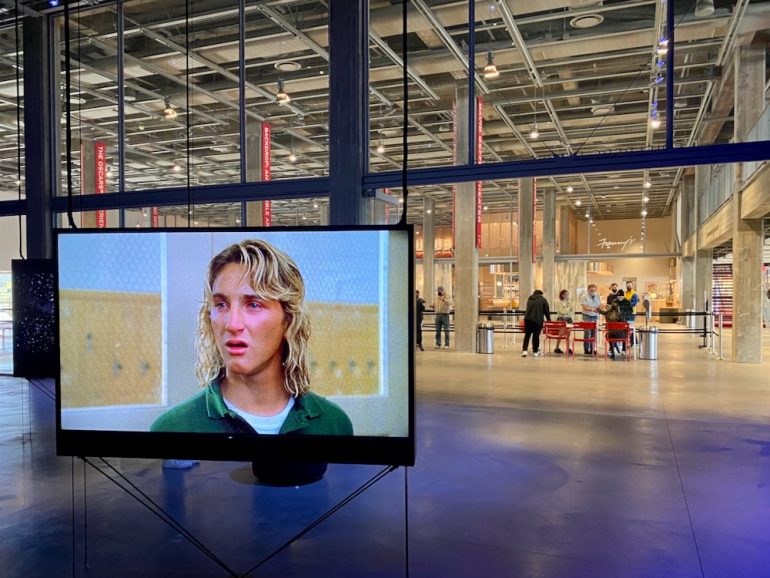 The museum exists to celebrate the movies, but in what must be directly related to the #Oscarssowhite blowback of a few years ago, the emphasis on oppression is relentless. (Imagine if Susan Sarandon made every other speech at the Academy Awards.) For example, an exhibit about the art of backdrops features a massive painting of Mount Rushmore—but the first text you see is four paragraphs about how the real-life monument desecrated land the Lakota consider sacred. That it’s true is beside the point of an exhibit about scenery in North by Northwest. I found it ham-fisted even when my own minority was in the spotlight!
The museum exists to celebrate the movies, but in what must be directly related to the #Oscarssowhite blowback of a few years ago, the emphasis on oppression is relentless. (Imagine if Susan Sarandon made every other speech at the Academy Awards.) For example, an exhibit about the art of backdrops features a massive painting of Mount Rushmore—but the first text you see is four paragraphs about how the real-life monument desecrated land the Lakota consider sacred. That it’s true is beside the point of an exhibit about scenery in North by Northwest. I found it ham-fisted even when my own minority was in the spotlight!
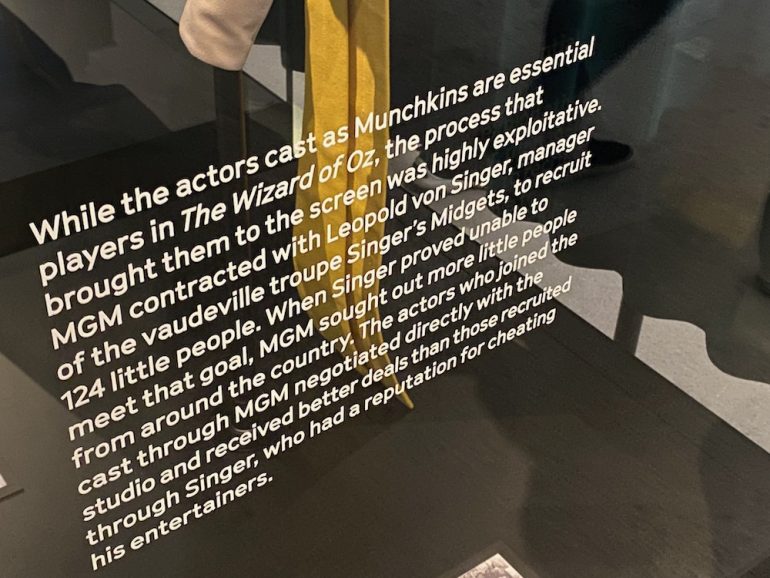
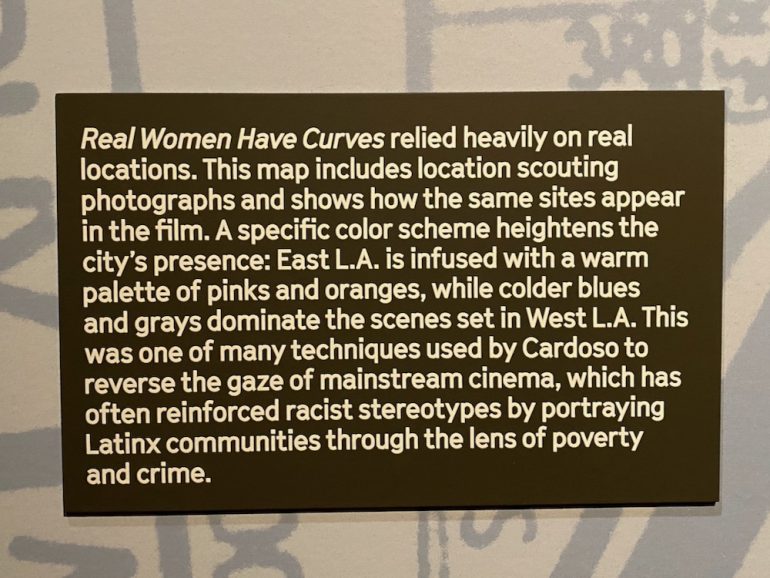
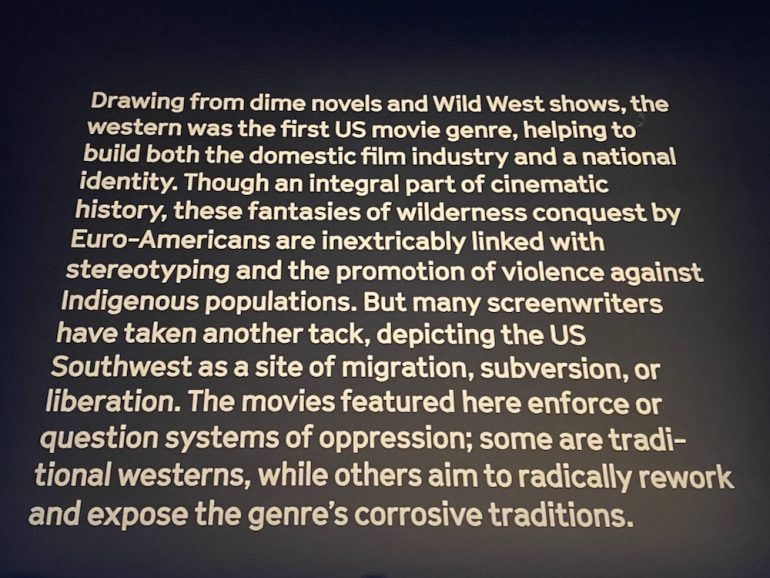 On the other hand, I rather liked the display about Native Americans who, when hired as extras in Westerns and asked to use their own language, improvised insults that no one caught till many years later.
On the other hand, I rather liked the display about Native Americans who, when hired as extras in Westerns and asked to use their own language, improvised insults that no one caught till many years later.
 Then, the museum does a volte-face with an exhibit devoted to director Pedro Almodóvar. The disclaimer at the entrance can hardly prepare you for the scene from 1993’s Kika—which has not aged well—where a character played by Rossy de Palma explains that the sole man she has had sex with is her brother, but it’s not incest because he’s “retarded,” and she only consents so that he doesn’t rape everyone in the village. After being nagged at over and over about Hollywood’s shitty treatment of just about everyone, it comes as a slap in the face. And, again, instead of an in-depth look at what makes Almodóvar so special—his new Parallel Mothers is a triumph, by the way—all we get are grids of posters and a bunch of screens showing clips. I could watch a dewy Antonio Banderas or Caetano Veloso sing “Cucurrucucú Paloma” all day long, but I’d prefer to learn something new.
Then, the museum does a volte-face with an exhibit devoted to director Pedro Almodóvar. The disclaimer at the entrance can hardly prepare you for the scene from 1993’s Kika—which has not aged well—where a character played by Rossy de Palma explains that the sole man she has had sex with is her brother, but it’s not incest because he’s “retarded,” and she only consents so that he doesn’t rape everyone in the village. After being nagged at over and over about Hollywood’s shitty treatment of just about everyone, it comes as a slap in the face. And, again, instead of an in-depth look at what makes Almodóvar so special—his new Parallel Mothers is a triumph, by the way—all we get are grids of posters and a bunch of screens showing clips. I could watch a dewy Antonio Banderas or Caetano Veloso sing “Cucurrucucú Paloma” all day long, but I’d prefer to learn something new.
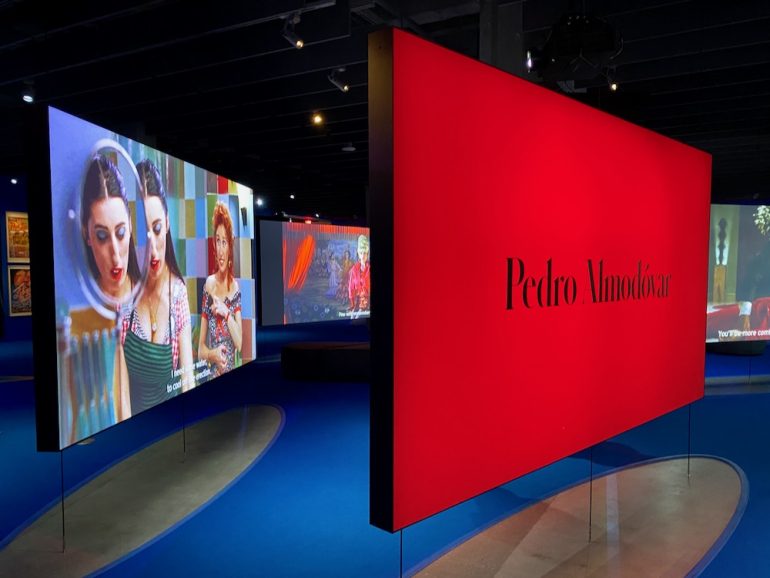
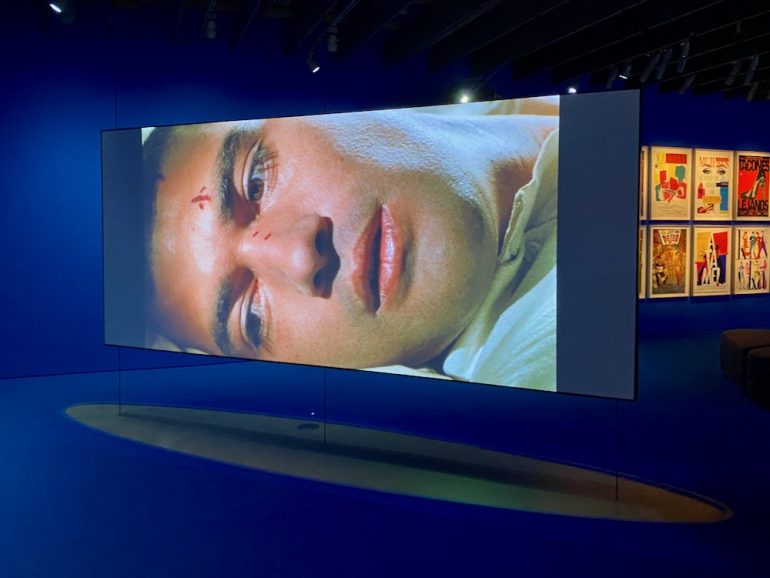 Although I had forgotten about this scene from Talk to Her….
Although I had forgotten about this scene from Talk to Her….
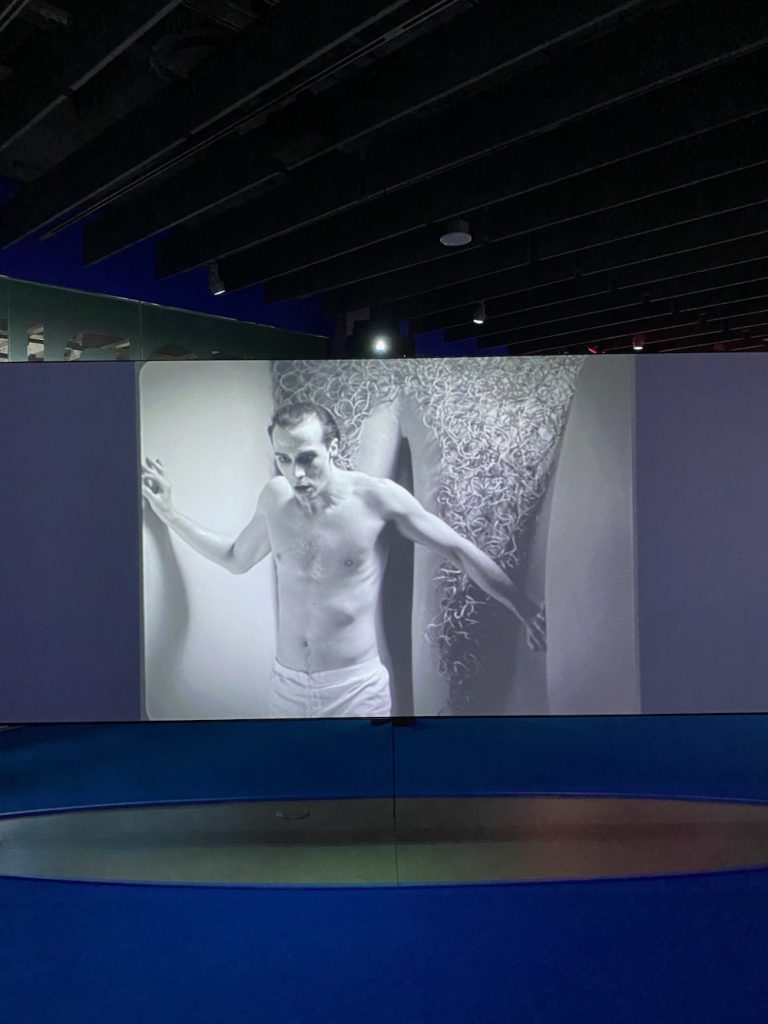 For all my criticism, the museum was hardly a total drag. There are many terrific behind-the-scenes exhibits, including makeup tests and Polaroids of costume tests, and I really enjoyed screening rooms where the folks responsible for the set design and sound effects for L.A. Confidential and Raiders of the Lost Ark, respectively, explained their choices.
For all my criticism, the museum was hardly a total drag. There are many terrific behind-the-scenes exhibits, including makeup tests and Polaroids of costume tests, and I really enjoyed screening rooms where the folks responsible for the set design and sound effects for L.A. Confidential and Raiders of the Lost Ark, respectively, explained their choices.
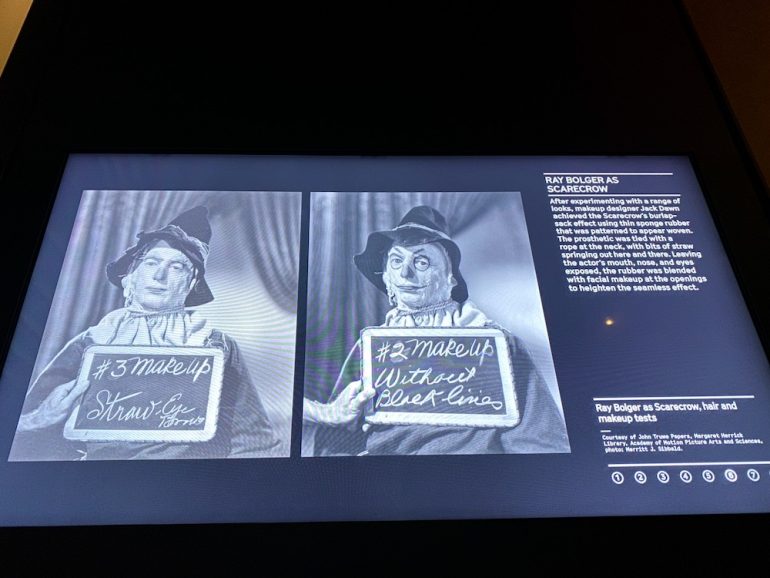
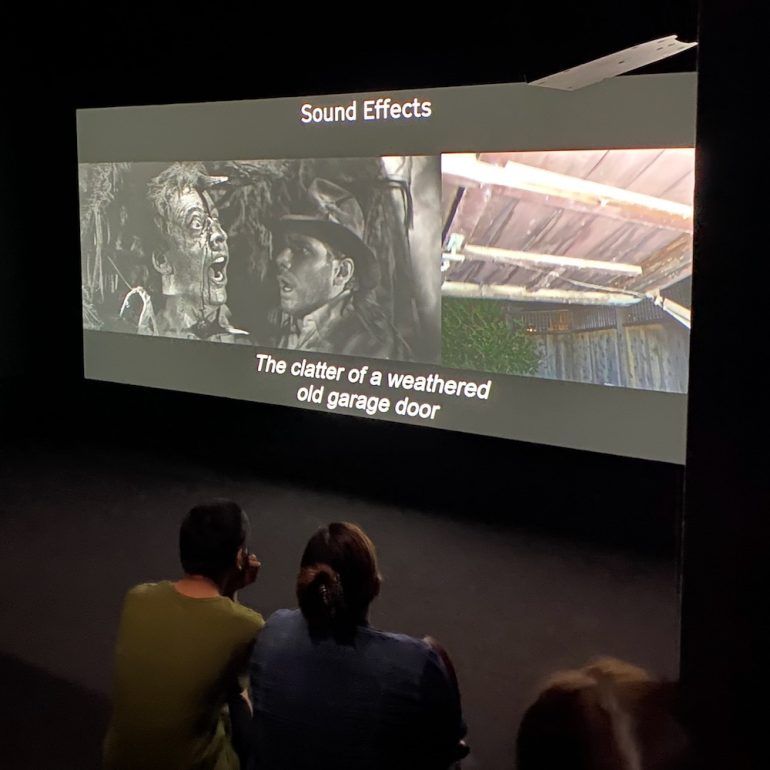 The exhibits on costumes and Oscar outfits were fun. Hello, Marilyn and Jane! You, too, Cher!
The exhibits on costumes and Oscar outfits were fun. Hello, Marilyn and Jane! You, too, Cher!
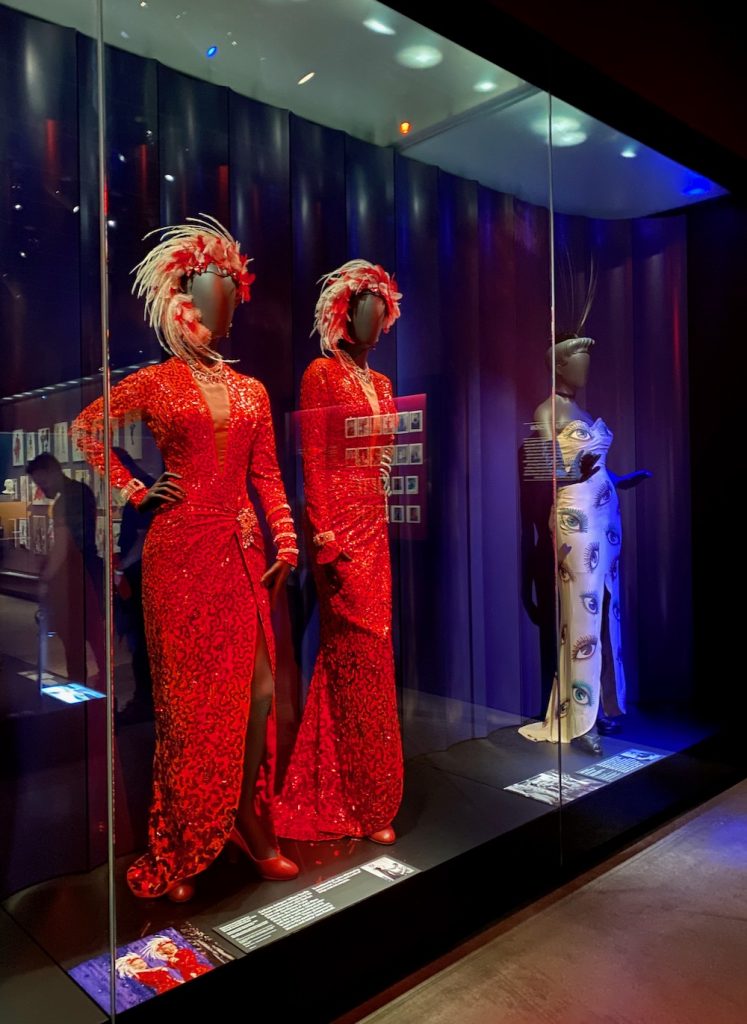
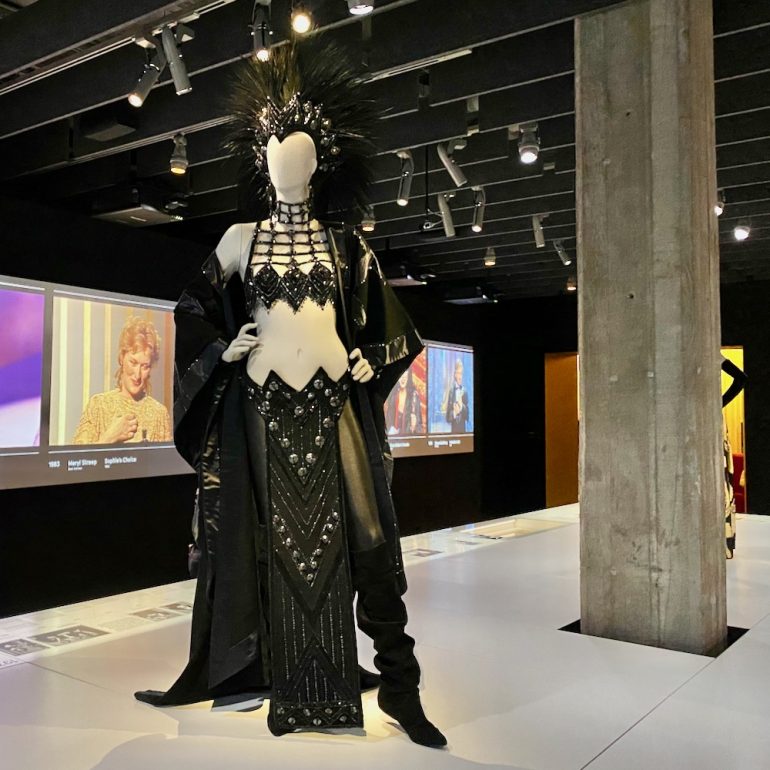 As usual, I was most enthralled by anything interactive. The room with sound by Hildur Guðnadóttir was fascinating. You could experience the sounds—not quite music, not quite effects—that create mood in movies, and without any visuals, your mind would come up with whatever it thought appropriate. As for the shadow play, I wasn’t given much time to work on my act.
As usual, I was most enthralled by anything interactive. The room with sound by Hildur Guðnadóttir was fascinating. You could experience the sounds—not quite music, not quite effects—that create mood in movies, and without any visuals, your mind would come up with whatever it thought appropriate. As for the shadow play, I wasn’t given much time to work on my act.
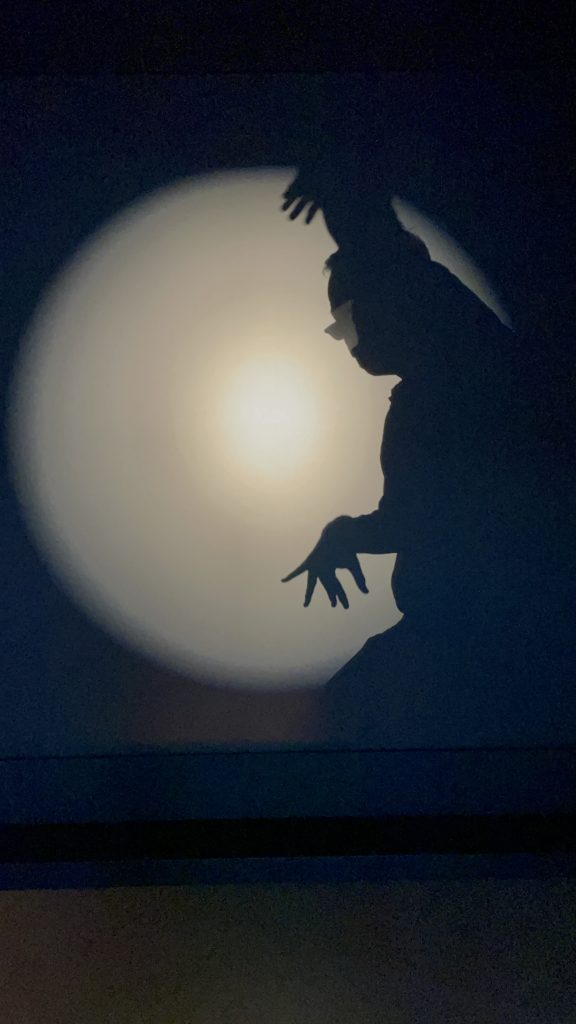
I think we’re all getting tired, so I’ll just point out two more things about the exhibits: the main draw right now is probably the one devoted to animation legend Hiyao Miyazaki, about whom I know nothing so I skipped it, and one of my favorite moments was the Pixar zoetrope, which I think you should experience without knowing much about it.
Time for fresh air: The theater building has a pleasant roof deck with, as one would hope, a view of the Hollywood sign in the distance.
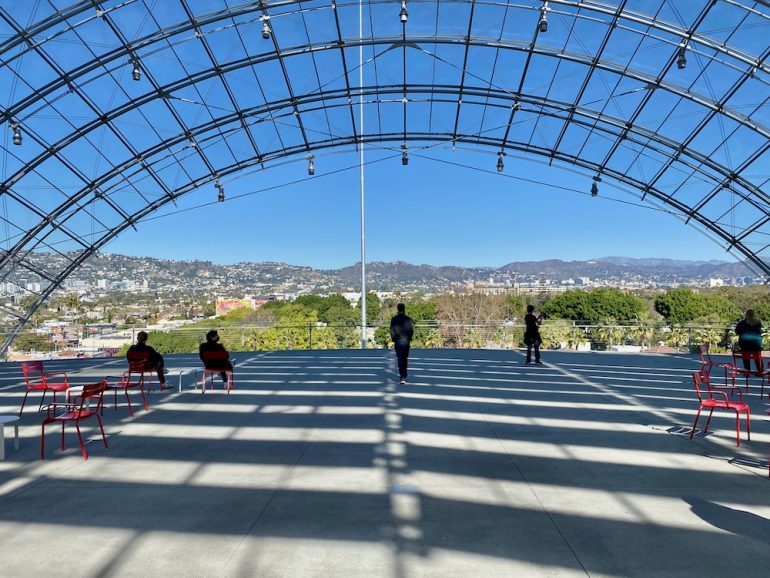 The third restaurant on our to-do list was at the museum: Fanny’s, from the folks behind Bestia in the Arts District, where we had a great meal years ago. The room has a grandeur and glamour that the rest of the museum lacks. At lunch, we learned when we got there, you order at a counter and staffers bring you your food; dinner is table service. The food was neither bad nor special, but (a) you could certainly do much worse in that part of town for lunch, and (b) I’d like to go back for dinner. When I lived in New York, any restaurant of that size gave me pause, but now that I’m a Santa Barbaran, it looks kind of fun, doesn’t it?
The third restaurant on our to-do list was at the museum: Fanny’s, from the folks behind Bestia in the Arts District, where we had a great meal years ago. The room has a grandeur and glamour that the rest of the museum lacks. At lunch, we learned when we got there, you order at a counter and staffers bring you your food; dinner is table service. The food was neither bad nor special, but (a) you could certainly do much worse in that part of town for lunch, and (b) I’d like to go back for dinner. When I lived in New York, any restaurant of that size gave me pause, but now that I’m a Santa Barbaran, it looks kind of fun, doesn’t it?
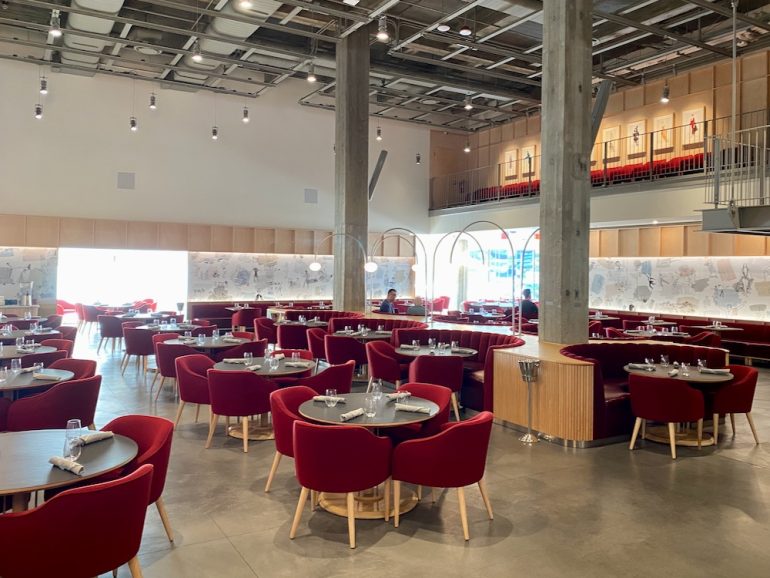
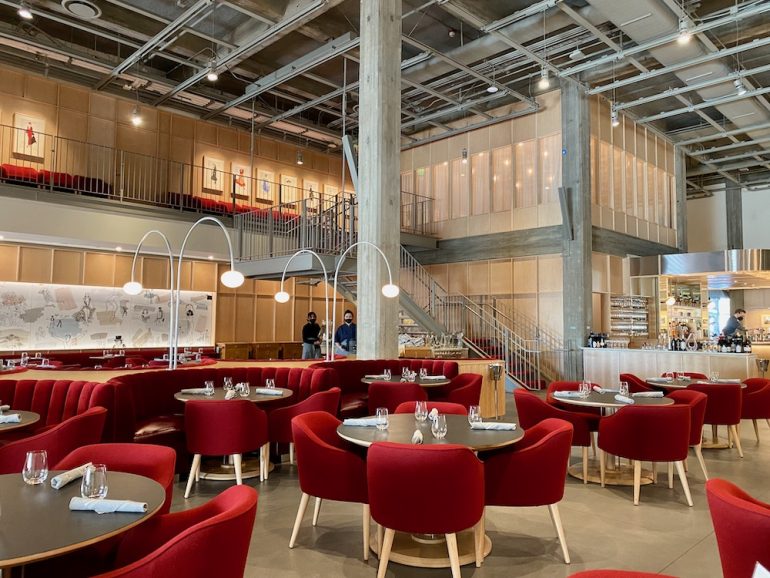
·············
Previous travel coverage:
••• From Penthouse to Pavement in Mexico City
••• Do Greek Islands Live Up to the Fantasy?
••• Splendid Isolation at Utah’s Lodge at Blue Sky
••• The Three Reasons to Visit Paso Robles Now
••• The Rebirth of the Cuyama Buckhorn, a Classic Roadside Motel


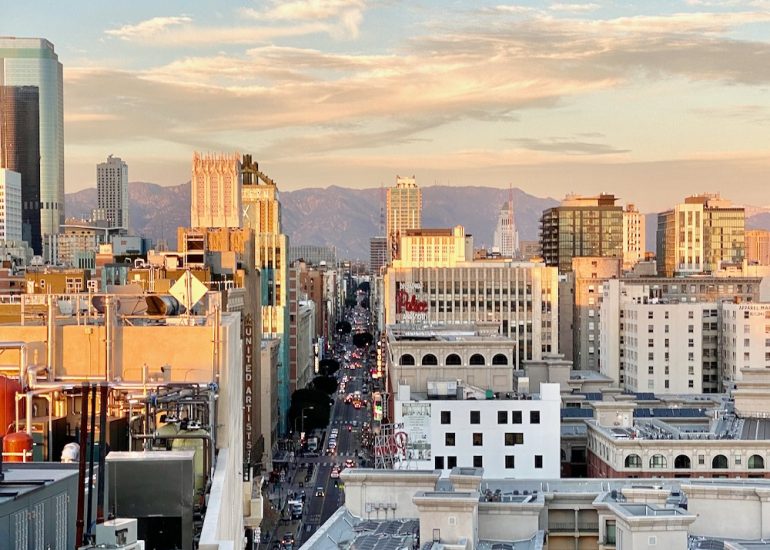







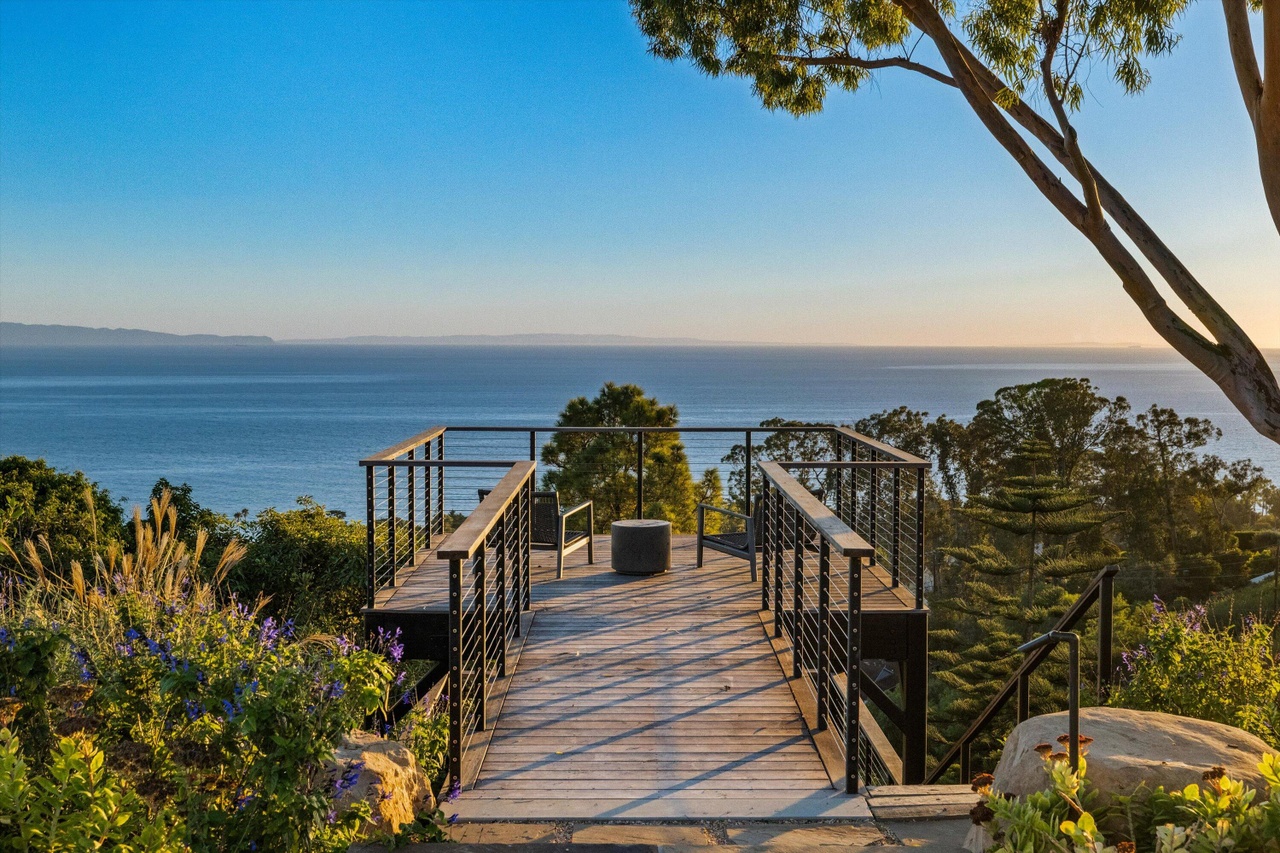



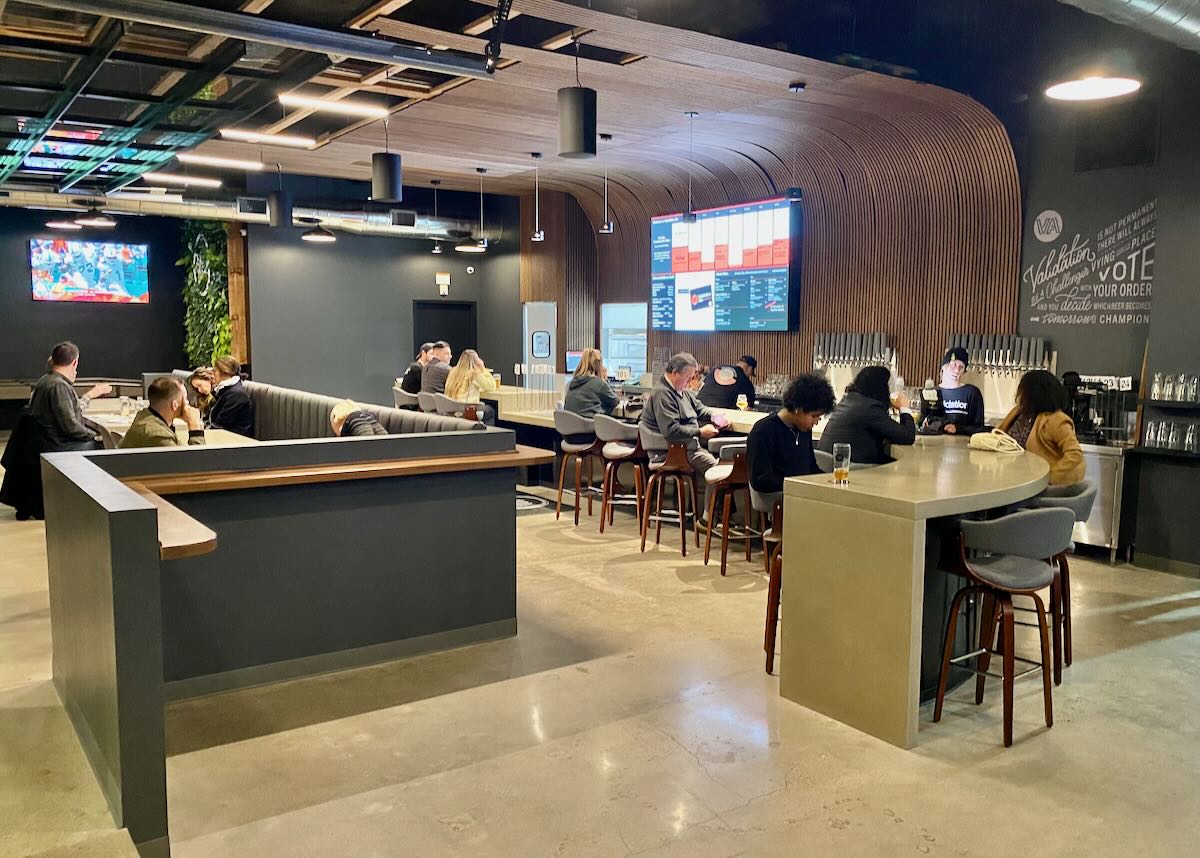
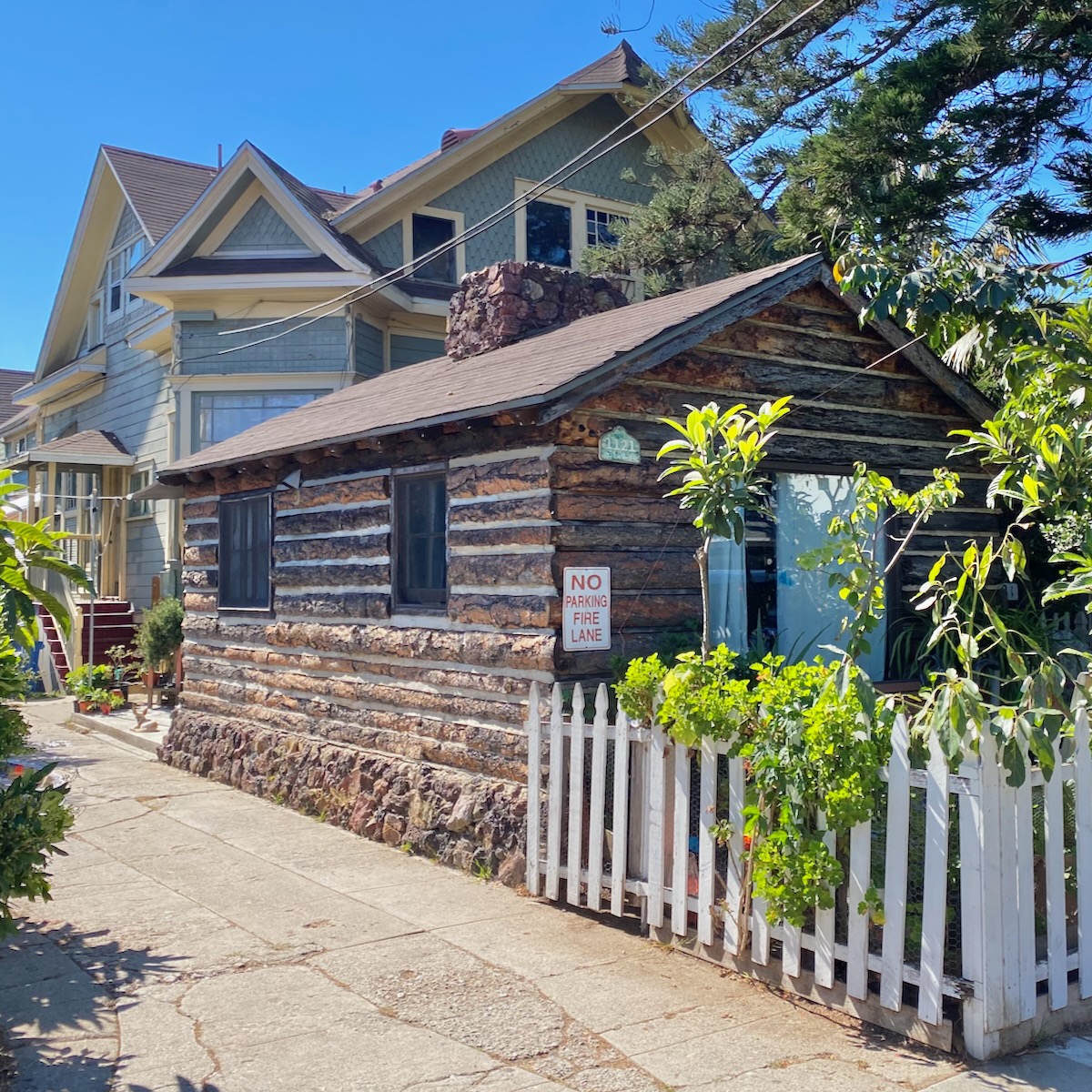


This whole post had me laughing out loud quite a few times. Especially the note about Native American actors improv, ha.
I just read (Noozhawk, I think) that Hearst Castle will be opening again soon for tours. I thought of you and your husband. There were, in the 80’s & 90’s, Zebra grazing on a ranch beside highway 1 that I suspect are still there, too. I don’t know anything about the food scene up that way but I’m sure there are some good restaurants to be found. Thx much
Zebras galore remain- was up in San Simeon 2 weeks ago. When I go, I take my own food✔️
Thanks, Christine, good to know! I need to get back up there for a visit.